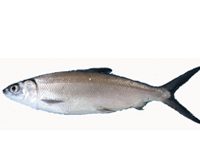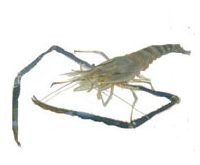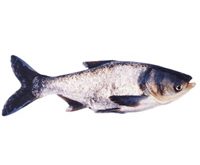SEAFDEC/AQD’s work on mangrove crab
Studies on mangrove crab at the SEAFDEC/AQD started in 1977, but were soon discontinued to give way to a priority shrimp species, Penaeus monodon. Studies were resumed in 1997 in collaboration with Australian Centre for International Agricultural Research (ACIAR) mainly to develop seed production and improve farming techniques. The project ran for 3 years. A collaborative four-year project was later funded by the European Union in 2002 for the culture and management of Scylla species. This involved not only SEAFDEC/AQD but the University of Wales Bangor (U.K.), University of Gent (Belgium), and Can Tho University (Viet Nam). The main objective was to improve the reliability and economic viability of mangrove crab hatchery and nursery production for mangrove-pond aquasilviculture production systems and stock enhancement. The Government of Japan Trust Fund partially funded the study on the domestication of mud crab in 2007 and recently on its selective breeding.

Grow-out studies on mangrove crab culture started in 1981 when researchers first tried different stocking densities. Two years later, trials on polyculture of mangrove crab with milkfish were conducted. In 1995, SEAFDEC/AQD initiated studies on mangrove crab culture in mangrove pens in Panay Island. Then trials on mangrove crab monoculture in tidal flats with existing mangroves were verified in various places in the country. A study was conducted to evaluate the effects of crab net pen systems on mangrove (Fig. 1) macroflora, and the replacement of dietary fish with low-cost pellets.
In 2007, a 30-month project on Enhancing the Adoption of Mud Crab Technology in Northern Samar was implemented under the Community Agricultural Technologies Project of ACIAR. The framework was based on the Institutional Capacity Development on Sustainable Aquaculture of SEAFDEC where science-based technologies are disseminated to coastal communities, Local Government Units and other stakeholders.
The various collaborations and the continuous activity on seed production enabled SEAFDEC/AQD to package mangrove crab technologies, conduct local and international training courses and on-site technology demonstrations, and publish extension manuals and scientific publication. Mangrove crab culture has also been one of the activities under the SEAFDEC/AQD’s Agree-Build-Operate-Transfer program and Institutional Capacity Development for Sustainable Aquaculture, which is meant to disseminate science-based aquaculture technologies to stakeholders.
Technology Viability
| A. Hatchery
|
B. Nursery
|
| C. Grow-out
|
D. Pens
|
List of technology adopters:
A. Mangrove Crab Hatchery/Nursery:
- WESAMAR Multi-species Hatchery, Villareal, Western Samar
- Crab Hatchery, Barangay, Dayao, Roxas City, Capiz
- Initao Hatchery, Misamis Oriental
- Crown Hatchery, Aroroy, Masbate
- Rajiv Gandhi Centre for Aquaculture, MPEDA, Tamil Nadu India
- ACDI/VOCA, Timor Leste
- ACE, ACELT, SPPI, and BVFMC, Samar
B. Brackishwater Pond Culture:
- Jalandoni and Montelibano Farms, EB Magalona, Negros
- Gargarita Farm, Himamaylan, Negros Occidental
- Rajiv Gandhi Centre for Aquaculture, MPEDA, Tamil Nadu India
- ACDI/VOCA, Timor Leste
C. Fattening of Mangrove Crabs in Cages and Pen Set in Mangroves
- Puerto Princesa City Government and the Manalo Multi-Purpose Cooperative Inc., Palawan
- KASAMA-CENRO, Buswang, New Washington
- Bugtong Bato, Ibajay Local Government Unit (LGU), Aklan
- Tangalan LGU, Aklan
- Batan (ask JHP)
- ACDI/VOCA, Timor Leste
Publications on Mangrove Crabs by SEAFDEC Researchers/Scientists:
Journals and Proceedings:
Quinitio ET, Parado-Estepa FD and Alava V. 1999. Development of hatchery techniques for the mud crab Scylla serrata. 1. Comparison of feeding schemes. Proceedings of the Mud Crab Scientific Forum, 20-24 April 1997, Darwin, Northern Territory, Australia. ACIAR Proceedings No. 78.
Parado-Estepa FD and Quinitio ET. 1999. Larval survival and megalopae production of Scylla sp. at different salinities. In: Proceedings of the Mud Crab Scientific Forum, 20-24 April 1997, Darwin, Northern Territory, Australia. ACIAR Proceedings No. 78. 174-177.
Millamena OM and Quinitio ET. 1999. Reproductive performance of pond-sourced Scylla serrata fed various broodstock diets. In: Proceedings of the Mud Crab Scientific Forum, 20-24 April 1997, Darwin Northern, Territory, Australia. ACIAR Proceedings No. 78. 114-117.
Millamena OM and Quinitio ET. 2000. The effects of diets on the reproductive performance of eyestalk ablated and intact mud crab Scylla serrata. Aquaculture 181:81-90.
Quinitio ET and Parado-Estepa FD. 2000. Transport of Scylla serrata megalopae at various densities and durations. Aquaculture 185:63-71.
Quinitio ET, Parado-Estepa FD, Millamena OM and Rodriguez EM. 2001. Seed production of mud crab Scylla serrata. In: Proceedings of the International Forum on the Culture of Portunid Crabs. Millamena OM, Quinitio ET and Blackshaw A. eds. 1-4 December 1998. Asian Fisheries Science 14(2):161-174.
Quinitio ET and Parado-Estepa FD. 2001. Simulated transport of Scylla serrata zoeae at various loading densities. In: Proceedings of the International Forum on the Culture of Portunid Crabs. Millamena OM, Quinitio ET and Blackshaw A. eds. 1-4 December 1998. Asian Fisheries Science 14(2):225-230.
Rodriguez EM, Quinitio ET, Parado-Estepa FD and Millamena OM. 2001. Culture of Scylla serrata megalops in brackishwater ponds. In: Proceedings of the International Forum on the Culture of Portunid Crabs. Millamena OM, Quinitio ET and Blackshaw A. eds. 1-4 December 1998. Asian Fisheries Science 14(2):185-190.
Lavilla-Pitogo CR, Marcial HS, Pedrajas SAG, Quinitio ET, and Millamena OM. 2001. Problems associated with tank-held mud crabs (Scylla spp.) In: Proceedings of the International Forum on the Culture of Portunid Crabs. Millamena OM, Quinitio ET and Blackshaw A. eds. 1-4 December 1998. Asian Fisheries Science 14(2):217-224.
Quinitio ET. 2003. Mud crab hatchery and grow-out status in the Philippines. In: Proceedings of the ACIAR Crab Aquaculture Scoping Study and Workshop. Allan G and Fielder D eds. 28-29 April 2003, Bribie Island, Queensland, Australia. P. 53-56.
Quinitio ET and Samraj T. 2007. Mud crab culture: Challenges and opportunities. In: Compendium of the proceedings of Technical Sessions of Aquaculture and Ornamentals at INDAQUA. Vishnu B, Thomas Ifs K, Muthuraman A, Vincent D and Kumar PA (eds). 11-13 January 2007, Chennai, India p. 70-80
Quinitio ET, de Pedro J and Estepa FD. 2007. Ovarian Maturation Stages of the Mud Crab Scylla serrata. Aquaculture Research 38:1434-1441.
de Pedro J, Quinitio ET and Estepa FD. 2007. Formalin as an alternative to trifuralin as prohylaxis against fungal infection in mud crab Scylla serrata (Forsskal) larvae. Aquaculture Research 38:1554-1562.
Lumasag G, Quinitio ET, Aguilar R, Baldevarona R and Saclauso C. 2007. Ontogeny of feeding apparatus and foregut of mud crab Scylla serrata (Forsskal) larvae. Aquaculture Research 38:1500-1511.
Alava VR, Quinitio ET, de Pedro J, Orosco Z and Wille M. 2007. Reproductive performance, lipids and fatty acids of mud crabs Scylla serrata (Forsskal) fed dietary lipid levels. Aquaculture Research 38:1442-1451.
Alava VR, Quinitio ET, de Pedro JB, Priolo FM, Orosco Z and Wille M. 2007. Lipids and fatty acids in wild and pond-reared mud crab Scylla serrata (Forsskal) during ovarian maturation and spawning. Aquaculture Research 38:1468-1477.
Rodriguez EM, Parado-Estepa F and Quinitio ET. 2007. Extension of nursery culture of Scylla serrata (Forsskal) juveniles in net cages and ponds. Aquaculture Research 38:1588-1592.
Lebata JHL, Le Vay L, Walton ME, Binas JB, Quinitio ET, Rodriguez EM and Primavera JH. 2009. Evaluation of hatchery-base enhancement of the mud crab Scylla spp., fisheries in mangroves: comparison of species and release strategies. Marine and Freshwater Research 60:58-69
Laranja JLQ, Quinitio ET, Catacutan MR and Coloso RM. 2010. Effects of dietary L-tryptophan on the agonistic behavior, growth and survival of juvenile mud crab Scylla serrata. Aquaculture 310:84-90
Quinitio ET, de la Cruz JJ, Eguia MRR, Parado-Estepa FD, Pates G and Lavilla-Pitogo CR. 2011. Domestication of the mud crab Scylla serrata. Aquaculture International 19:237-250.
Parkes L, Quinitio ET and Le Vay L. 2011. Phenotypic differences between hatchery-reared and wild mud crabs, Scylla serrata and the effects of conditioning. Aquaculture International 19:361-380.
Ates MCD, Quinitio GF, Quinitio ET and Sanares RC. 2011. Comparative study on the embryonic development of three mud crabs Scylla spp. Aquaculture Research 43:215-225.
Quinitio ET and Estepa FDP. 2011. Survival and growth of mud crab Scylla serrata, juveniles subjected to removal or trimming of chelipeds. Aquaculture 318:229-234
Books and Manuals:
Quinitio ET, Rodríguez EM and Estepa FD. 2009. Nursery and grow-out of mud crab. In: Training Handbook on Rural Aquaculture. Chapter 4.4. p. 87-95. SEAFDEC/AQD, Iloilo
Quinitio ET and Parado-Estepa FD. 2003. Biology and Hatchery of Mud Crabs Scylla spp. Aquaculture Extension Manual No. 34. SEAFDEC/AQD, Iloilo, Philippines. 42pp.
Quinitio ET and Noe Lwin MM. 2009. Soft-shell Mud Crab Farming. SEAFDEC/AQD, Iloilo, Philippines. 19pp.
 SEAFDEC/AQD Southeast Asian Fisheries Development Center | Aquaculture Department
SEAFDEC/AQD Southeast Asian Fisheries Development Center | Aquaculture Department








